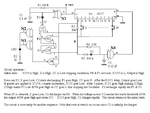Kolero
Member level 1
- Joined
- Dec 10, 2010
- Messages
- 41
- Helped
- 0
- Reputation
- 0
- Reaction score
- 0
- Trophy points
- 1,286
- Location
- Vancouver, BC
- Activity points
- 1,795
Hi all
I'm looking for a circuit that is somewhat specific, but I also feel that it's simple to do.. I just can't find a schematic online that does what I want.
I'd like a circuit that uses 555 timer(s) to generate 3 short tones, about 1000 Hz, in fairly quick succession (within about a second) when it receives input from the output of a voltage comparator. It should not not beep again until after the input drops (so I guess it gets reset). I'd also like for it to run on 12v and I have an 8Ω, 0.25w speaker.
And in case that's too confusing, this is what I'm doing:
I have a proximity sensor that has an input of 5v and an output of 0.4-3.1v, depending on how far or near an object is. I have a 12v wall wart, and a LM7805 to feed the 5v to the sensor.
The sensor output is going to a LM393 voltage comparator and when 0.4v is detected, the comparator sends 12v to this new circuit.
This new circuit I'm looking for will beep 3 times quickly then stop. If an object remains in the path of the sensor, it won't beep again until the object is moved and then replaced.
This is for a door sensor. I'll mount it above a door frame and when someone walks in, the circuit beeps. If someone stands under the sensor, I don't want it to keep beeping.
I'm looking for a circuit that is somewhat specific, but I also feel that it's simple to do.. I just can't find a schematic online that does what I want.
I'd like a circuit that uses 555 timer(s) to generate 3 short tones, about 1000 Hz, in fairly quick succession (within about a second) when it receives input from the output of a voltage comparator. It should not not beep again until after the input drops (so I guess it gets reset). I'd also like for it to run on 12v and I have an 8Ω, 0.25w speaker.
And in case that's too confusing, this is what I'm doing:
I have a proximity sensor that has an input of 5v and an output of 0.4-3.1v, depending on how far or near an object is. I have a 12v wall wart, and a LM7805 to feed the 5v to the sensor.
The sensor output is going to a LM393 voltage comparator and when 0.4v is detected, the comparator sends 12v to this new circuit.
This new circuit I'm looking for will beep 3 times quickly then stop. If an object remains in the path of the sensor, it won't beep again until the object is moved and then replaced.
This is for a door sensor. I'll mount it above a door frame and when someone walks in, the circuit beeps. If someone stands under the sensor, I don't want it to keep beeping.
